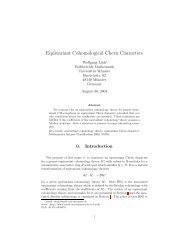Connes-Chern Character for Manifolds with Boundary and ETA ...
Connes-Chern Character for Manifolds with Boundary and ETA ...
Connes-Chern Character for Manifolds with Boundary and ETA ...
You also want an ePaper? Increase the reach of your titles
YUMPU automatically turns print PDFs into web optimized ePapers that Google loves.
CONNES-CHERN CHARACTER AND <strong>ETA</strong> COCHAINS 33<br />
If j + q is even then, since j < q, E q anti commutes <strong>with</strong> αE 1 · . . . · E j K <strong>and</strong> hence<br />
similarly<br />
Tr(αE 1 · . . . · E j K) = − Tr(E 2 q αE 1 · . . . · E j K) = Tr(E q αE 1 · . . . · E j KE q )<br />
= Tr(E 2 q αE 1 · . . . · E j K) = − Tr(αE 1 · . . . · E j K) = 0. □<br />
We will make repeated use of the equations (2.31)–(2.34). Now we can proceed as<br />
<strong>for</strong> a θ–summable Fredholm module. Following [GBVF01, p. 451] we start <strong>with</strong> the<br />
supercommutator<br />
∫<br />
([ ]) b Str q Dt , a 0 e −σ 0D 2 t [Dt , a 1 ] . . . [D t , a k ]e −σ kD 2 t dσ. (2.36)<br />
∆ k<br />
As in [Get93a, bottom of p. 37] one shows, using Proposition 1.9 <strong>and</strong> the fact that<br />
∫<br />
e<br />
−λ 2 dλ = √ π, that this supercommutator equals<br />
〈a 0,∂ , [D ∂ t , a 1,∂ ], . . . , [D ∂ t , a k,∂ ]〉 D ∂<br />
t<br />
. (2.37)<br />
It is important to note that here we are in the case q + 1, where the grading is the<br />
induced grading on the boundary <strong>and</strong> E q+1 = −Γ.<br />
For convenience we will write D instead of D t . Exp<strong>and</strong>ing the supercommutator<br />
(2.36) on the other h<strong>and</strong> gives<br />
b 〈[D, a 0 ], . . . , [D, a k ]〉<br />
k∑<br />
+ (−1) j−1 b 〈a 0 , [D, a 1 ] . . . , [D, a j−1 ], [D 2 , a j ], . . . , [D, a k ]〉,<br />
j=1<br />
(2.38)<br />
where we have used [D 2 , a j ] = [D, [D, a j ]] Z 2.<br />
We can now calculate the effect of b <strong>and</strong> B on b Ch.<br />
B b Ch k+1 (D)(a 0 , . . . , a k )<br />
k∑<br />
= (−1) kj b 〈1, [D, a j ], . . . , [D, a k ], [D, a 0 ], . . . , [D, a j−1 ]〉<br />
j=0<br />
k∑<br />
=<br />
b 〈[D, a 0 ], . . . , [D, a j−1 ], 1, [D, a j ], . . . , [D, a k ]〉<br />
j=0<br />
= b 〈[D, a 0 ], . . . , [D, a k ]〉,<br />
(2.39)<br />
where we used (2.32) twice. Thus, the first summ<strong>and</strong> in (2.38) equals<br />
B b Ch k+1 (D)(a 0 , . . . , a k ).

















